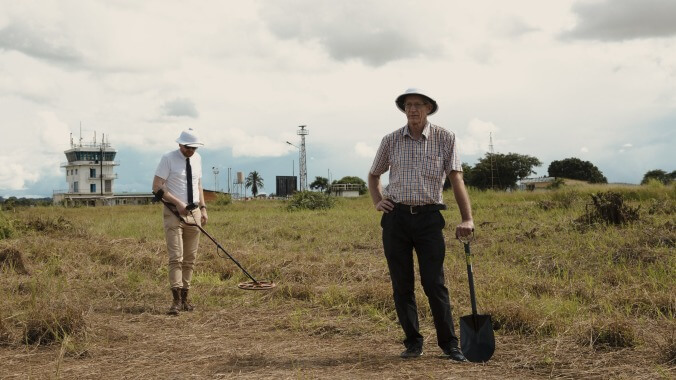In Cold Case Hammarskjöld, a gonzo journalist spins a wild conspiracy theory


What really happened to Dag Hammarskjöld? Was the plane crash that killed the United Nations secretary-general and 15 others on the night of September 18, 1961, just as he was on his way negotiate a cease-fire with Belgian-backed Katangese forces in the Congo Crisis, the result of pilot error, as the initial investigations concluded? Or was Hammarskjöld’s plane shot down? Was it the work of Belgian mercenaries? The copper-mining conglomerate Union Minière? British intelligence? The CIA? Or a shadowy white supremacist paramilitary group with possible links to all four, improbably named the South African Institute For Maritime Research (SAIMR)?
The Danish gonzo journalist and filmmaker Mads Brügger is hardly the first person to put forward the idea that Hammarskjöld was the victim of geopolitical foul play, and will certainly not be the last. In fact, most of the information that appears in his sardonic documentary Cold Case Hammarskjöld was previously detailed in Susan Williams’ book Who Killed Hammarskjöld?: The UN, The Cold War And White Supremacy In Africa, which reawakened interest in the crash and inspired an ongoing United Nations inquiry. (Though Brügger, who is not above inserting himself into a story, never mentions Williams. Go figure.) But then to claim that the film is really about Hammarskjöld would mean playing along with its elaborate ruse. Brügger, by his own admission, is less interested in the idealistic Swedish diplomat than in the potential villains of the story: corporate and imperialist forces; secret alliances between intelligence networks and extremist hired guns; white authorities who, for whatever reason, chose to sweep the testimonies of black eyewitnesses under the rug. And if he can’t actually give a definitive conclusion about the circumstances of Hammarskjöld’s death, he can at least spin one heck of a conspiracy theory. Which, to be clear, is almost certainly a crock.
Having made a specialty of documentary stunts with The Red Chapel and The Ambassador, Brügger here adopts the role of paranoid investigator, narrating Cold Case Hammarskjöld, from a hotel room in Kinshasa with Post-It notes on the walls to two secretaries who occasionally serve as audience stand-ins. (Why two secretaries? Brügger says he doesn’t know.) His straight man is Göran Björkdahl, a Swedish aid worker who started his own investigation into Hammarskjöld’s death. Filmed over the course of several years, Cold Case initially focuses on their attempts to uncover new evidence and conduct “enormous amounts of interviews with elderly, white, liver-spotted men,” presented by Brügger with a flair for self-parodying showmanship: dressing up in G-man suits to chase down leads in South Africa, donning colonial pith helmets as they try to dig up the possible resting place of the wreckage outside an airport in Zambia. “It’s a bit like in films where people have to dig their own graves,” Brügger jokes, always a step ahead of his own potential embarrassment.
But more and more, his attention drifts away from the plane crash and toward SAIMR and the L. Ron Hubbard-esque figure of Keith Maxwell, an opportunist, quack doctor, reputed soldier of fortune, and serial fabulist who left behind a trail of paranoia and a rambling, seemingly autobiographical manuscript after his death. SAIMR enters the story through “Operation Celeste,” a document that appears to describe the plot to assassinate Hammarskjöld, first uncovered by the Truth And Reconciliation Commission chaired by Desmond Tutu in 1998. At the time, Operation Celeste was dismissed by intelligence agencies as a vintage forgery produced by the Soviets during the Cold War. This is the kind of denial on which great conspiracy theories are born—because if, say, SAIMR were real, why would so many people pretend it never existed? And what did Maxwell—a man who, at different times and to different people, implied himself to be a British intelligence asset, a mad scientist obsessed with creating a white majority in South Africa, and the servant of a decades-long international conspiracy—have to do with it?
Brügger’s fascination with Maxwell and the fear and suspicion he still seems to inspire in the people who knew him is hard to resist. Told with fourth-wall-breaking, connect-the-dots mania, it’s a heck of a story, extending beyond the 1960s into the AIDS pandemic, possible human medical experimentation, and phony vaccines. It is filled with people who believe that they were part of something terrifying. But the real question isn’t whether it’s true, but how much of it Brügger actually believes. Even if it did at one point operate as a mercenary company, SAIMR was also in many ways an elaborate con, probably created by Maxwell—a man who may have never actually been privy to state secrets, but who had a knack for leading all the right people to believe that he did. If Brügger shares the doubts of Williams and other Hammarskjöld conspiracy theorists about Operation Celeste (in all likelihood a hoax, though not a Soviet one), he doesn’t let them get in the way of a good story. As for the latest official U.N. inquiry, its report is due sometime this year. But then, can you really trust it?